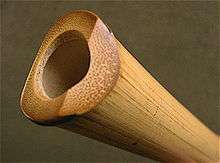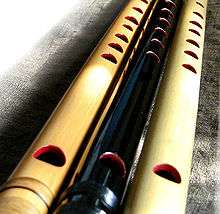Fue
Fue (笛, hiragana: ふえ) is the Japanese word for flute, and refers to a class of flutes native to Japan. Fue come in many varieties, but are generally high-pitched and made of a bamboo called shinobue. [1] The most popular of the fue is the shakuhachi.
Categorization
Fue are traditionally broken up into two basic categories – the transverse flute and the end-blown flute. [2] Transverse flutes are held to the side, with the musician blowing across a hole near one end; end-blown flutes are held vertically and the musician blows into one end. [3]
History
The earliest fue may have developed from pitch pipes called paixiao in Chinese.[4] The gabachi instruments eventually made its way over to Japan from China in the fifth century, [5] becoming prevalent during the Nara Period.
Soon after the introduction of fue instruments, members of the Fuke sect of Zen Buddhism made normal use of the shakuhachi. These "priests of nothingness" viewed the instruments as spiritual tools, using them for suizen, or "blowing meditation".[6] Modern fue performance may feature a soloist or involve either a chamber or large ensemble of the instruments.
Instruments
Japanese fue include many different varieties of Japanese flute, including the following:
| Image | Name | Type | Description |
|---|---|---|---|
 |
Shakuhachi | End-blown | One of the most popular and oldest of the Japanese fue |
 |
Hotchiku | End-blown | Made from the same material as the Shakuhachi |
| Hichiriki | End-blown | A unique fue in that it is a double reed instrument. | |
| Gakubue | Transverse | Traditional fue | |
| Komabue | Transverse | This fue is for komagaku, a type of music used for dances associated with gagaku Imperial Court music. | |
| Ryūteki | Transverse | Used in Japanese music seeming to have a Chinese origin. Its sound is said to represent the ascension of dragons. | |
| Nōkan | Transverse | A flute used in the Noh theatre and hayashi ensembles. | |
 |
Shinobue | Transverse | Also called the bamboo flute, it is used for nagauta, the background music used in kabuki theatre. |
| Kagurabue | Transverse | This fue is used in a type of Japanese music called mikagura. At 45.5 cm long, it is the longest fue. | |
| Minteki (a.k.a. Seiteki) | Transverse | Used in ceremony. The sympathetically vibrating membrane, such as on a Chinese dizi, is visible in the photograph between the embouchure hole and finger holes. |
References
| Look up fue in Wiktionary, the free dictionary. |
| Wikimedia Commons has media related to Fue. |
- Taiko - Japanese Drumming." Archived 2008-08-21 at the Wayback Machine, Drumdojo Magazine, Ed. Paul Marshall, 2000, retrieved 6 July 2008
- "Fue (Flute)." Japanese Traditional Music". Archived 2008-03-11 at the Wayback Machine, 2002, Columbia Music Entertainment, retrieved 6 July 2008
- "Fue (Flute)", Japanese Traditional Music Archived 2008-03-11 at the Wayback Machine, 2002, Columbia Music Entertainment, retrieved 6 July 2008
- Malm, William P. Traditional Japanese Music and Musical Instruments. 1959. Rev. ed. Otowa: Kodansha International, 2000.
- Tagliaferro, Linda. "Music and Nature in a Japanese Flute." New York Times, 10 May 1998 retrieved 6 July 2008
- Tagliaferro, Linda. "Music and Nature in a Japanese Flute". New York Times, 10 May 1998, retrieved 6 July 2008